A pair of neurologists from Stanford University believe their specialty must take the lead on ensuring patients with cardiovascular implantable electronic devices (CIEDs) have access to MRI when necessary. MRIs of the brain and spine are crucial for diagnosing a range of neurological conditions, they noted, but most CIEDs remain MR-nonconditional.
“Legacy” CIEDs such as pacemakers, implantable cardioverter defibrillators and cardiac resynchronization therapy devices have traditionally been considered unsafe in an MRI setting because of “concerns over device malfunction and local tissue injury from migration and heating,” Collin J. Culbertson, MD, and Carl A. Gold, MD, MS, wrote in a viewpoint published in JAMA Neurology.
However, two recent studies have shown that patients with properly programmed devices can safely undergo MRI scanning with low rates of adverse events, prompting CMS to announce in January it is considering rescinding coverage restrictions for these legacy devices.
Still, Culbertson and Gold said protocols at the institutional level are necessary for CIED patients to safely and consistently undergo MRIs. Cardiologists, radiologists and device technicians will play a factor in these safety measures, the authors wrote, but they believe “neurologists are in a unique position to champion” appropriate protocol at local centers.
“Without the input of neurologists, institutional policy change may be inefficient or include stipulations that unnecessarily restrict access for some patients, such as those requiring emergency MRI examinations,” Culbertson and Gold wrote. “Neurologists can work with radiology colleagues to develop disease-specific imaging protocols that minimize device downtime and artifact production and maximize the value of 1.5(-Tesla) sequences. Within their institution or individual practice, neurologists can rigorously measure the association of MRI with patient outcomes to demonstrate benefit.”
Read the full article below:

